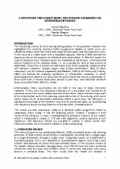-
Past ETC Papers

Browse, search and view papers from the past AET Conferences.
-
Members' Area

AET promotes networking and exchange of ideas, information and opportunities amongst members.
Conference Papers 2009
Noordwijkerhout, Netherlands
ETC Conference Papers 2009
A departure time choice model for dynamic assignment on interurban networks.
Seminar
Day 2 (6 Oct 2009), Innovative Methods in Transport Analysis, Planning, Dynamic Equilibrium, 19:00 - 22:00
Status
Accepted, documents submitted
Authors
V Aguilera, N Wagner, UPE, LVMT, Ecole des Ponts ParisTech, FR
Short abstract
We present an extension of Vickrey's bottleneck model tailored for interurban networks, as part of a project with Cofiroute. The emphasis is on the relaxation of the original assumptions to meet the specificities of interurban travelling behavior.
Abstract
The increasing interest for time-varying tolling policies in transportation networks has enlighten the need for dynamic traffic assignment models in which users are allowed to choose both their route from origin to destination and their departure time. In the case of a single route with a bounded capacity, Vickrey (1969) derived the departure rate as the outcome of individual cost minimization. In Vickrey's model, for a given departure time, individual costs are
modelled as continuous, uniminimal and convex functions of the schedule delay, i.e. as a penalty for early or late arrivals at destination. Since then a number of extensions have been proposed, notably to deal with complex networks, multiple origins and multiple destinations. Most of those extensions are tailored for studying equilibrium in metropolitan networks, in which commuting travel patterns are assumed: the preferred arrival time to a destination is
often taken from a normal distribution around a peak hour, and individual schedule costs essentially follow Vickrey's model (see for instance Heydecker and Addison (2005) or de Palma and Lindsey (2006)).
Unfortunately, those assumptions do not hold in the case of large interurban networks. Typically, French highway operators have began to show interest in time-varying tolls to deal with the high level of traffic their network encounter during summer holidays. In this case, the economic behavior of a trip-makers w.r.t. its preferred arrival
time vary widely from one to the other. Some travellers may want to be at destination early in the morning, some others late in the evening, while some others require to be at destination absolutely before a
given hour, etc. Moreover, a significant percentage of the travellers may wish to avoid the peak day, by rescheduling their departure day to the day before or to the day after, if incented to do so.
This article presents extensions made to a dynamic traffic assignment model to encompass those needs. The focus is mainly put on distinctive features of the model, including:
- the description of the demand, for which no restriction is made on the distribution of preferred arrival times to destination;
- the class of schedule delay cost functions that are considered, which are not required to be convex, nor continuous;
- a formulation of the user equilibrium with departure choice as a Nash equilibrium, that allows for a formal proof of existence;
- the algorithm used to compute the equilibrium.
Some results from numerical studies on the French highway network are also presented.
Documents:

Association For
European Transport
Forester House
Doctors Lane
Henley-in-Arden
Warwickshire, UK
B95 5AW
+44 (0) 15 64 793552
VAT number: 710 1866 64
Conference Supporters & Endorsers




Legal Entity
The Association for European Transport is registered as an Association ('vereniging') with the Chamber of Commerce for Haaglanden in The Netherlands under company number 27170096.
Built on Zenario




